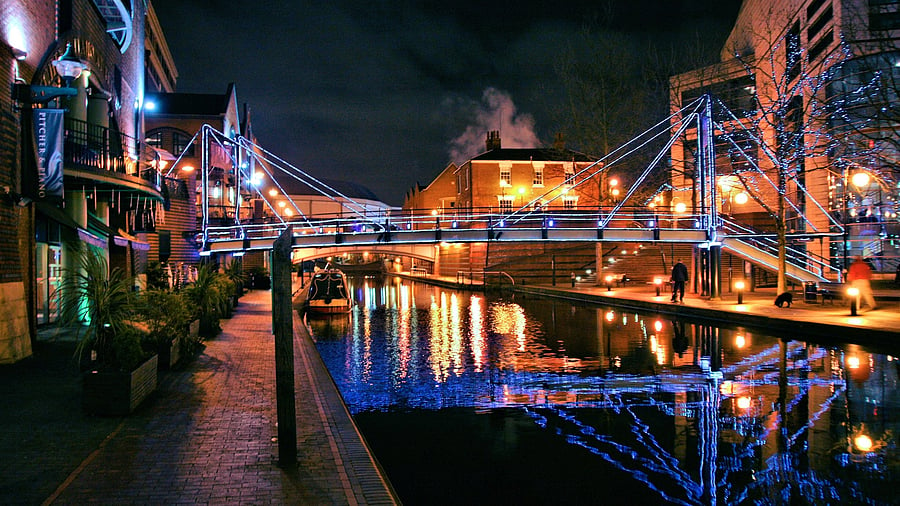
Birmingham has a large network of canals.
Image courtesy Wikipedia
A holiday in Birmingham? The second city of the United Kingdom often loses out in the tourism sweepstakes, but things have changed since Peaky Blinders put the spotlight on “Brum”. Steven Knight’s show about the infamous Shelby family and its rule over the city’s lawless streets after World War I has attracted a record number of visitors to Birmingham and inspired street art, walking tours, and theme nights.
But long before Peaky Blinders became its calling card, Birmingham was a renowned industrial centre.
In 1791, Arthur Young, a renowned writer on British economic life, anointed Birmingham the “first manufacturing town in the world”. The city witnessed a growth spurt during the 18th century amid the Midlands Enlightenment and the Industrial Revolution. Advances in science, technology and economic development led to innovations that formed the bedrock of modern industrial society. Other industrial rivals such as Manchester emerged in the mid-19th century, but Birmingham’s varied industrial base stood the city in good stead. The “city of a thousand trades” soon became the world’s leading manufacturer of metalware, but also had numerous other thriving industries “such as brass, toys, jewellery, guns, pins, coins, medals, steel pens, and electroplating”. “Buttons were created from a huge range of materials and Birmingham also made flint glass, papier-mâché, and japanning ware,” according to History West Midlands.
Workers practising a range of specialised and skilled trades in the small workshops encouraged creativity and innovation. Birmingham became home to inventions that changed the world: the discovery of Oxygen, the “Penny Black” stamp, whistle, dental drill, bicycle bell, Birmingham screwdriver and gauge, spring-loaded door lock, mechanical pencil sharpener, and more.
I learned that from the early 20th century onwards, the people of nearby Black Country, one of the birthplaces of the Industrial Revolution, helped change the world. “The region is said to be named for the 30-foot-thick coal seam or the soot and air pollution created by the coal mines, brickworks, iron foundries, and glass factories,” a hotel staffer tells me.
The Black Country was a hotbed of innovation: its people built the world’s first successful steam engine; put the first steam train (the Stourbridge Lion) on US soil; produced the anchor for the Titanic; practically built the Crystal Palace; and fuelled the introduction of the first minimum wage. History comes to life at the Black Country Living Museum in Dudley, which pays tribute to the life and work of the area’s ancestors. Set over 26 acres, the carefully reconstructed shops, houses, and industrial areas take me back in time, with people dressed in period costumes showcasing life and work during a revolutionary period of history.
The award-winning open-air museum, which incidentally served as the backdrop to all six seasons of Peaky Blinders, traces the timeline of industrialisation and reveals how Birmingham became a manufacturing powerhouse.
The Birmingham Back to Backs, a set of working-class houses in the town centre, reveal the life of the people. Seen mainly in the Midlands and the North during the 19th century, houses like these were built back-to-back around a communal courtyard, with a shared toilet and laundry facilities.
The last residents moved out in the 1960s but Court 15, Birmingham’s last surviving court of back-to-back houses, survived as many of the units fronting on to a main street became shops and stayed in business until the 21st century.
The Jewellery Quarter, home to over 800 jewellers and retailers, and more than 200 listed buildings, is the jewel in Birmingham’s crown. Dating back over 200 years, the area is the beating heart of British jewellery — about 40% of the country’s jewellery is made here. The Quarter’s Chamberlain clock takes pride of place, and the area now has numerous restaurants, bars, and a thriving arts scene. A short walk away are two Grade II-listed cemeteries: Warstone Lane Cemetery and Key Hill Cemetery. Many noted Birmingham residents are buried here, including Harry Gem the inventor of lawn tennis; Marie Bethell Beauclerc, the first female reporter in Britain; and Alfred Bird, better known as Birmingham’s ‘Mr Custard’. Apart from Birds Custard, the Jewellery Quarter was also the birthplace of iconic British brands Cadbury Chocolate, HP Sauce, and Typhoo Tea.
The city’s large network of canals, which helped kickstart the industrial revolution with the busy waterways transporting coal, iron, and other goods, offers an interesting vantage point. Interestingly, Birmingham’s canals are longer, mile-wise, than those in Venice.
The industrial city took a heavy hit during the Birmingham Blitz (1940-1943), following heavy bombing by the German Luftwaffe. The damage done to the city’s infrastructure and new buildings led to extensive urban regeneration subsequently.
Today, Birmingham is the social, cultural, financial and commercial centre of the Midlands. That means there’s plenty to do after exploring the city’s industrial heritage — but only after partaking in Birmingham Balti, a chicken curry dish created in 1975 by a local Pakistani restaurateur.
The Birmingham Museum and Art Gallery houses Anglo-Saxon treasures and the largest collection of pre-Raphaelite paintings in the world.
Not to be missed are Aston Hall, a Grade I-listed Jacobean mansion; the Library of Birmingham, Europe’s largest library that houses a million printed volumes; and Coffin Works, which offers a deep dive into the traditions of coffin-making (including the fitting made for Winston Churchill).
Families love the world-famous Cadbury’s World and the Spitfire Gallery with authentic WWII-era aircraft. The self-guided Graffiti Art of Digbeth Walk takes you on a 4-km stroll to explore some of the amazing graffiti around Digbeth. The amble drives home the point that Birmingham has embraced the future with open arms, but also kept its industrial past alive.